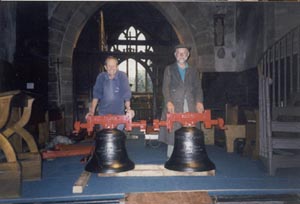
Visiting ringers to the small Staffordshire village of Lapley are often surprised
by the large central tower of the church. The reasons for this dates back to
the 11th century when Benedictine monks from the Abbey of St. Remigius, Rheims,
formed a cell at Lapley and built a church and priory. This survived until the
dissolution of alien priories by Henry V in the year 1414, after which the church
became the parish church of Lapley. At about this time the North and South transepts,
which made the original building of cruciform shape, were demolished to reduce
the size of the structure in accordance with the small population of the village.
The first bell was placed in the tower in 1565 and has no inscription apart
from the date. It is now number six in the peal of eight. Three further bells
were added in the 17th century, of which only one still survives; this is dated
1629 and forms the 7th of the augmented peal. These two old bells were hung
on canons from wooden headstocks. In 1929, work was undertaken by J. Taylor
and Co. to recast the other two of the original four bells, add a new treble
bell and rehang the bells in a metal frame, which contained a pit for a further
sixth bell. Obviously this was done with a view to subsequent augmentation,
but the bells remained a ring of five for almost 50 years. During this time
there were attempts to form a local band but none were very successful or long
lasting, and by the 1970s the bells were suffering from neglect and only rung
occasionally by visiting bands.

This situation could easily have continued but for the happy coincidence of
two people moving into the parish at the same time. In 1974, Bill Deason, who
had been an active ringer in Middlesex and the South of England during the 1960s,
moved for work purposes to Wheaton Aston, another village forming a combined
parish with Lapley. At the same time a new vicar, Revd. George Smith, was appointed
and called round houses in the village to introduce himself. Bill's wife, Barbara,
was then at home with two young children and, in the ensuing conversation, she
mentioned her husband's bellringing activities. "Ah good" said the
vicar "I have a tower with five bells and I want them rung". So a
band was duly taught, the bells began to be regularly rung, and in 1977 for
the Queen's Silver Jubilee the treble bell of the ring of six was finally added. Unfortunately the Revd. Smith left the parish soon after for pastures new. Further
troubles loomed, for after a couple more years a crack was found in the tower
and all ringing had to be suspended.
For 15 years the bells remained silent as vicars came and went without the funds
to undertake any strengthening work being available, but happily the situation
changed in 96. The tower was repaired, the bells could be rung and, once again,
Bill started teaching a local band; a task that was only made possible with
the help of other ringers within the area. There is now regular ringing and
an enthusiastic local band. Following the death of his widowed mother in 2001,
Bill offered to buy two new trebles in memory of his parents, if the band would
undertake the fund-raising for the frame and installation costs. This they did
with such enthusiasm that the target was soon set to not only add the two new
trebles, but to also replace the wooden headstocks on the two old bells with
the modern metal canon retaining type.

After a summer of the usual local fundraising and appeals for money from charitable sources, we were sufficiently close to the target to be able to place the order for the new bells and headstock upgrade with the Loughborough Foundry in late July. Here thanks must be recorded for the financial support received from many individuals and organisations in both ringing and local government. One reads criticism sometimes that ringers have a stingy reputation; we can only report the exact opposite. We have been amazed and gratified by the generosity of so many and we are deeply grateful to all who have helped.
The bells were installed in September with local labour to assist the bell hanger and reduce costs. The whole project went without any problems and at 4pm on Friday 13 September some weary and grubby bell hangers assistants stood with some more wholesome ringing friends and pulled off for the first time. After a few rounds and call changes to get the feel of the new bells, we stood. One of the band commented that "they are a really happy peal of bells" and I can think of no more suitable a description. Friday the 13th may have a reputation for bad luck but it certainly didn't apply to us that day. There is further work to do to tidy up the belfry and to try and reduce the sound level of the bells in the ringing chamber, but most of our objective is now achieved. Visiting bands will be most welcome to try our new ring and share our enthusiasm for them.